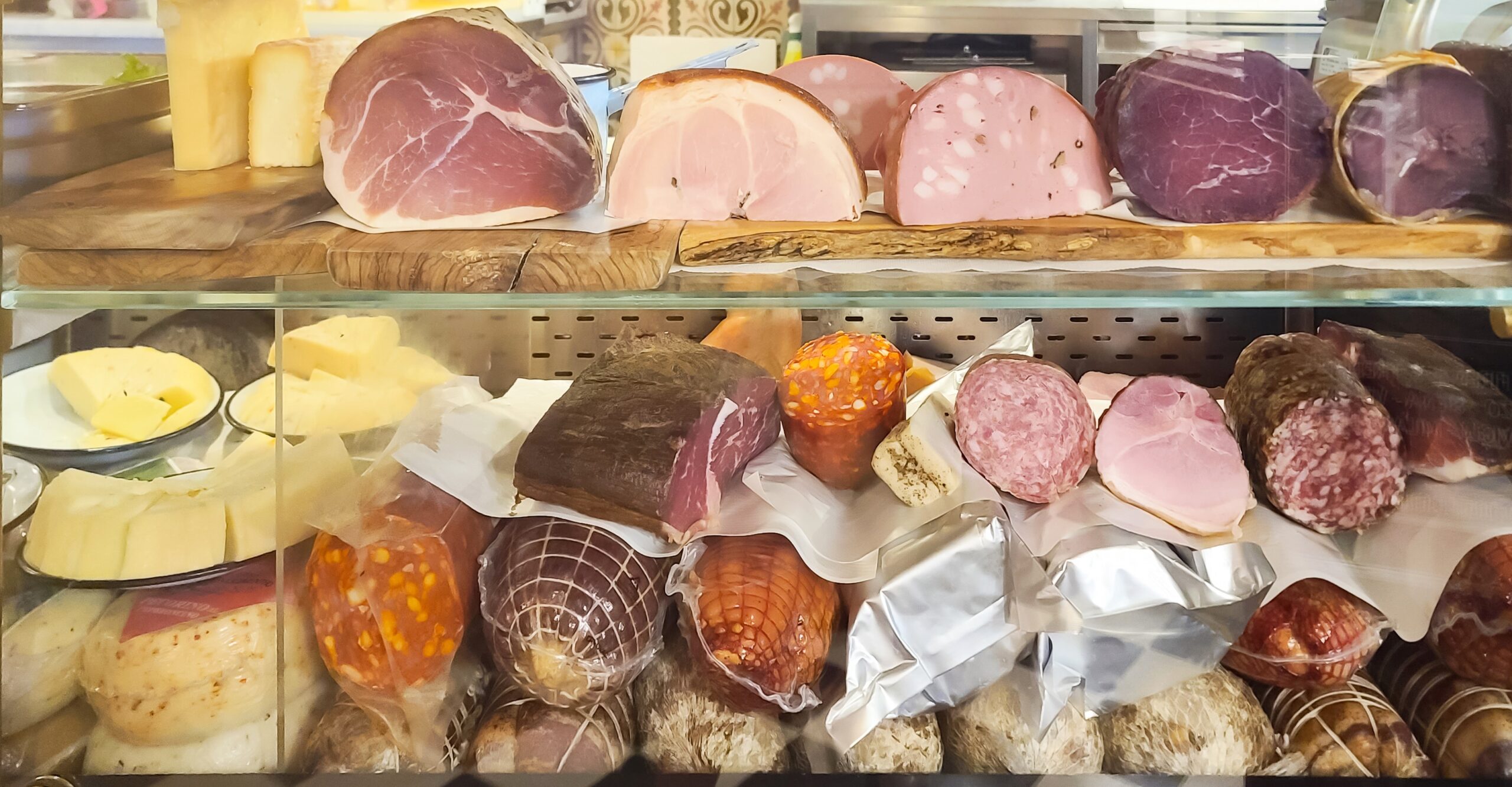
I am a person of nostalgic lunchmeat experience: One of the deepest gustatory pleasures of my childhood involved stripping a bologna round of its red plastic casing, slicking on a generous smear of mayonnaise, twirling it into a rubbery tube — or a cone, in the occasional case of a pickle cameo — and quickly devouring it.
I still feel a flutter of longing when I clock festive pinks and yellows in a refrigerator case; every corned beef sandwich I’ve eaten since has probably been a Freudian attempt to recapture some of that magic.
So when I say lunchmeat is convenient and delicious, it’s from a place close to both my heart and my stomach, and completely without contempt.
But even I have to admit that deli meat has baggage. In large and varied studies, regularly eating processed meats — including cold cuts and hot dogs — leads to higher rates of cancers and cardiovascular disease.
These products are also at high risk for contamination with listeria — outbreaks of which have made headlines recently, including one involving tainted Boar’s Head liverwurst that has sickened 57 people and killed nine since July, and has prompted a wave of lawsuits. Listeria is a nasty little bug that can cause vomiting, diarrhea, and meningitis, and can be deadly in particularly vulnerable people.
Experts say there’s no amount of lunchmeat that’s healthy to eat. Still, out of convenience, pleasure, or pure sentimentality, it often remains on the menu. If you’re one of the many people with a special place in your gut for deli sandwiches, there are still ways to minimize their harm.
What that pastrami sandwich is doing to your body
Cold cuts are different from other kinds of meat in one important way: They’re processed in ways that delay spoilage. That processing involves a range of different methods, including drying (as in beef jerky), fermenting (as in many salamis and pepperonis), smoking (as in country ham), and curing with salt or other additives (as in many hot dogs and a wide range of lunchmeat).
Processing meat adds more to it than just shelf life.
Curing, often using nitrates and nitrites — preservatives that prevent spoilage and preserve meat’s pinkish color — and salt, is one of the more common ways food manufacturers extend the life of modern cold cuts. When they reach the gut, nitrates and nitrites can be converted into a variety of molecules, among them ones that can be harmful to your health. These compounds occur naturally in some foods, including leafy vegetables, but combining them with animal protein — especially with protein containing high levels of heme iron, like beef and pork — raises the chance they’ll transform into those bad actors.
Smoking meat also changes its chemical composition. Cooking animal protein at a high temperature and burning its dripping juices and fat create amazing flavors — but also, a whole other set of gnarly compounds.
Transforming the chemical structure of meat in these ways has health consequences for people who eat a lot of it. In 2015, the World Health Organization released a report concluding that eating just 50 grams of processed meat daily — about the equivalent of a hot dog — increased a person’s lifetime colorectal cancer risk by 18 percent. Other studies suggest processed meat consumption also increases breast, prostate, esophageal, and pancreatic cancer risk.
Eating processed meat can also raise the risk of cardiovascular disease, including heart attacks and strokes, in part due to their high salt content — which raises blood pressure — and their high levels of saturated fats. In one large European study, a daily hot dog led to a 30 percent increase in cardiovascular disease rates.
It’s not just the deli meat in a deli sandwich that can affect your health, says Julia Zumpano, a registered dietitian at the Cleveland Clinic Center for Human Nutrition. The supporting players — including bread, condiments, cheese, and other goodies — are also part of the nutritional picture, so they also bear some consideration, for better or for worse.
Why lunch meat is particularly prone to contamination
Deli meat’s long and winding path from production facility to table also creates multiple opportunities for microbial contamination. Chunks of meat often get processed and mushed together into a slab in one place, sliced in another, then moved “from the conveyor belt to the packaging center, to the cooler, to the semi, to the distributing center, to another semi, to the grocery store, and then it sits there until someone buys it,” says Zumpano.
The recent liverwurst outbreak involved listeria, a bacteria that’s particularly dangerous to newborns and people who are pregnant, immunocompromised, or aged 65 and above. However, lunchmeat has also been associated with salmonella and Campylobacter infections. The contamination sometimes happens in filthy production plants — as in the latest Boar’s Head outbreak — but can also happen when tainted meat spreads bacteria to other products through contact with knives or meat slicers at a deli counter.

A harm-reduction approach to sandwiches
Zumpano says — very sadly for my fellow bologna lovers — that the healthiest lunchmeat is no lunchmeat at all. Still, you may consider what the alternative is when packing your lunch. If you’re replacing a hoagie with fast food or something from a vending machine, she says, “Maybe that deli meat sandwich could have been a little bit healthier — depending on the deli meat.” (It’s worth noting that even Zumpano says she eats deli meat from time to time.)
If you’re simply not ready to break up with cold cuts, you can still do a lot to minimize your sandwiches’ health risks.
Buying cold cuts at a deli counter is a great first step. This is where you can find the preservative-free meats that won’t last long on supermarket shelves. If you have access to meat freshly cut at the time of sale, “You can probably get a turkey breast that is just sliced turkey” — nitrate- and nitrite-free, unsmoked, and without tons of added salt, says Maya Feller, a registered dietitian nutritionist based in Brooklyn. (The fatty, preservative-filled stuff is also likely to be available at deli counters, so you still need to approach your decisions here critically.)
Zumpano says — very sadly for my fellow bologna lovers — that the healthiest lunchmeat is no lunchmeat at all
There’s a small convenience sacrifice in making this choice: Because preservative-free meats have shorter shelf lives, you might need to buy less of it more often. “When I buy fresh meat off the bone, I buy a half pound versus a pound,” says Zumpano.
If you’re nowhere near a deli counter or you’re not ready to give up packaged cold cuts, you still have a range of choices. Don’t bother looking at the front of the package — that’s all marketing, says Zumpano — and instead, flip it over to look at the more detailed information on the back.
Feller starts by looking at the ingredient list. The meat you’re expecting to eat should be the first ingredient on the list, not water or other ingredients that serve as fillers or binders, she says. She also advises looking at how much of the daily recommended allowance of sugar, saturated fat, and salt is in one serving of the product; these should all come close to or be below 5 percent.
The back of the package should also tell you if nitrates or nitrites are in the product. Here, don’t assume that natural is necessarily better: Some manufacturers add celery or beetroot powder to their products to take advantage of their naturally high levels of nitrates, but there’s no evidence that meat cured with these products is less harmful. Natural or not, these chemicals can cause the same damage as synthetic nitrates, says Cristian Jimenez Martinez, a biochemist at Mexico’s National Polytechnic Institute who authored a recent review on natural preservatives. “The dose makes the poison,” she wrote in an email to Vox.
The same goes for higher-end artisanal products, which are not necessarily better for us, either. There’s an odd egalitarianism in knowing small-batch charcuterie and mass-produced baloney can both achieve the same level of carcinogenicity, which makes it especially important for consumers to understand what they’re eating.
Although public health authorities generally recommend that pregnant and immune-compromised people in particular avoid cold cuts to avoid the risk of listeria infections, people can also safely consume these products by heating them first. Some health experts recommend zapping them in the microwave under a damp paper towel until steaming; Zumpano pan-fried lunchmeat when she was pregnant.
If you’re up for a radical change, you can give your sandwiches a full makeover. One option is to thin-slice leftover meats or other proteins you’ve cooked at home. (Zumpano often suggests her clients cook double the amount of protein they plan to eat at dinnertime, then put the rest on a sandwich or atop a salad the next day.) For a convenient shelf-stable option that’s rich in protein but is less processed than lunchmeat, low-sodium canned chicken and fish are good bets.
Life is full of opportunities to trade a little risk for a little pleasure, and sandwiches offer a daily opportunity to make that trade
You can also make your ham sandwich healthier by making changes to the vehicle holding the lunchmeat. Replacing heavily processed bread with bread that contains water, flour, yeast, salt, and maybe some added grains or seeds can increase the nutritional value of a sandwich. So can switching out mayo for hummus or avocado spread, which typically contain healthier fats and some soluble fiber. It’s always good to ramp up vegetable content too by adding more tomatoes, bell peppers, cucumbers, and other garden favorites.
Life is full of opportunities to trade a little risk for a little pleasure, and sandwiches offer a daily opportunity to make that trade. For long-term health, the key is to choose the lower-risk option more often and save the higher-risk option for moments of celebration.

Recent Comments